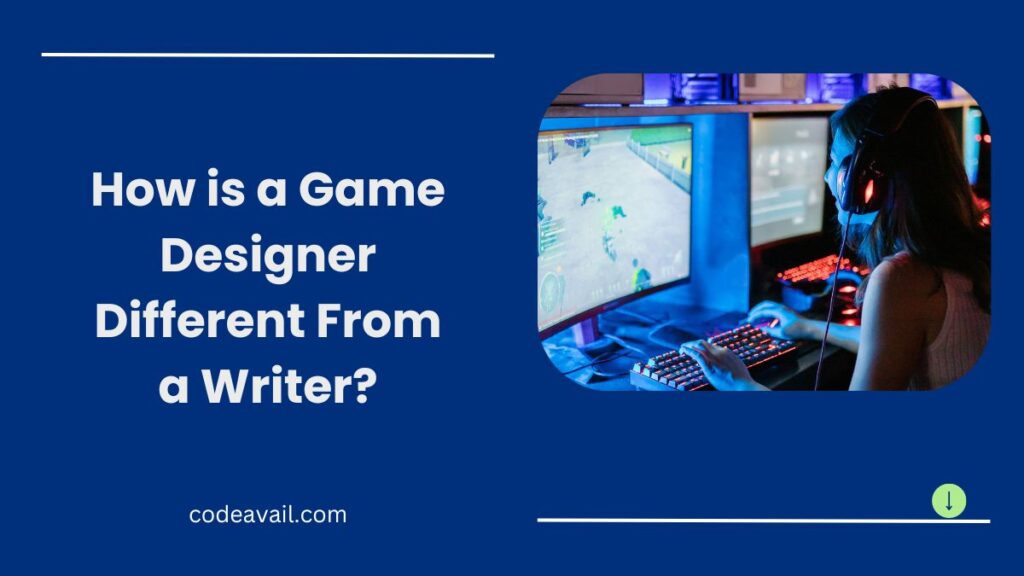In the world of entertainment, two creative roles often stand out: the game designer and the writer. Both play crucial parts in creating captivating experiences for their audiences. But how are they different? Are they just two sides of the same coin, or do they have distinct roles and responsibilities? In this blog, we’ll explore how is a game designer different from a writer in simple language.
How is a Game Designer Different From a Writer?
Table of Contents
Purpose of Creation
A game designer’s primary goal is to create interactive and engaging experiences for players. They design gameplay mechanics, levels, and overall game structures. Their focus is on user engagement and the overall experience of playing the game.
On the other hand, a writer’s primary purpose is to tell a story or convey information through words. They create characters, dialogues, and narratives to captivate readers or viewers. While a story can be a part of a game, a writer’s primary focus is not gameplay but the written content.
Creativity and Imagination
Both game designers and writers are creative individuals, but their creativity is channeled differently. Game designers use their creativity to build game worlds, design puzzles, and come up with innovative mechanics to make the game fun and exciting. They imagine how players will interact with the game elements.
Writers, on the other hand, use their creativity to craft engaging plots, characters, and dialogues. They immerse readers or viewers in the story’s world through their words, allowing them to visualize and emotionally connect with the narrative.
Medium of Expression
Game designers primarily work with interactive mediums like video games. They use technology and design principles to create gameplay experiences. This involves programming, level design, and user interface design. Their medium of expression is often code and visual assets.
Writers, on the other hand, work primarily with traditional written forms such as novels, short stories, screenplays, or even non-fiction articles. Their medium of expression is language, and they rely on words to convey their ideas and stories.
Collaboration
Game designers often work in multidisciplinary teams, including programmers, artists, sound designers, and more. Collaboration is essential in game development to bring the designer’s vision to life. Game designers need to communicate their ideas effectively to the team, ensuring that the gameplay aligns with the game’s overall vision.
Writers may collaborate with editors, illustrators (in the case of illustrated books), and publishers. However, the creative process for a writer is more solitary compared to a game designer’s, as they often work alone to create the text.
Player Interaction
One of the most significant distinctions between game designers and writers is the level of player interaction. Game designers create experiences where players actively participate and make choices. Players’ decisions impact the outcome and shape the narrative. Game designers need to anticipate and design for different player choices, creating branching storylines and various outcomes.
Writers, on the other hand, craft a linear experience. While readers or viewers can interpret the text differently, the story itself remains unchanged. A reader’s interaction with a written piece is more passive compared to a player’s engagement with a game.
Testing and Iteration
Game designers engage in extensive playtesting to refine and improve the gameplay experience. They observe how players interact with the game and use player feedback to make necessary adjustments. Game development often involves multiple iterations to ensure the game is enjoyable and balanced.
Writers, while they may seek feedback from beta readers or editors, do not have the same iterative process as game designers. Once a book or script is published, the content remains largely static, with limited opportunities for revision.
Goals and Objectives
Game designers create games with specific objectives, such as challenging players, providing entertainment, or conveying a message through interactive experiences. The success of a game is often measured by factors like player engagement, completion rates, and critical acclaim.
Writers, on the other hand, aim to achieve different goals, depending on the type of content they produce. For example, a novelist’s goal may be to tell a compelling story, while a journalist aims to inform and educate. Success for a writer is typically gauged by factors like book sales, critical reviews, or the impact of their written work on readers.
Conclusion
In summary, game designers and writers are both integral to the world of entertainment and storytelling, but their roles and responsibilities differ significantly. Game designers focus on creating interactive, engaging gameplay experiences, whereas writers primarily craft written narratives to captivate readers or viewers. They express their creativity in unique ways, work with different mediums, collaborate differently, and have distinct approaches to player interaction and iteration.
Understanding these differences can help aspiring game designers and writers choose the path that aligns with their creative interests and talents. Whether you want to design interactive worlds or weave compelling stories with words, both roles offer exciting opportunities to make a mark in the realm of creativity and entertainment.
